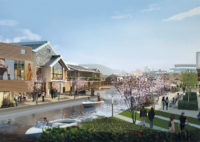While the Sichuan earthquake of May 2008 killed more than 80,000 people and left more than 4.8 million homeless, it created the chance to rethink development in some parts of the devastated province. For example, in the small town of Longchi, where almost 2,000 local residents were left homeless, plans for a new highway linking the mountain town to Chengdu opened the opportunity to tap into the growing tourism market.
Instead of rebuilding Longchi as just a home for displaced residents, planners envisioned the town as a place where tourism could provide jobs and new public amenities for local residents. This year’s awards jury praised the project, saying, “This plan provides an ecologically and economically sustainable strategy for developing a vibrant small town in a beautiful mountain valley.”
But Longchi’s valley location posed a real challenge to the design team. To determine appropriate development sites, it conducted an in-depth geographic-information-system-based analysis, reviewing topography, hydrology and solar orientation among other factors. With limited land suitable for development, the designers decided not to separate areas for residents and tourists, but to integrate them. “Program location and circulation were planned carefully to allow interaction between local residents and tourists to create a sustainable social structure,” says Yiwen Zhu, a senior urban designer at AECOM. Bringing the two user groups together also reduced the amount of land needed for each one.
Highlights of the master plan include a visitor center, a waterfront plaza, a pedestrian street linking mixed-use spaces, and a conference/cultural center. A wetland park captures runoff and filters the water before it runs into the drinking reservoir of Chengdu. For buildings and landscaping, the designers adapted vernacular architectural models and local materials, connecting the project to its context and reducing its carbon footprint.
Since the town straddles the Longxi River, the project team needed to accommodate periodic flooding while still making the waterfront accessible to the public. says Zhu. “One of our biggest design moves was to break the existing flood walls boxing in the water, and turn the northern bank of the river into a terraced water plaza.” On the southern bank, AECOM created a waterfront pedestrian street, as well as courtyard buildings with 15,000 square meters of retail space where residents can run family businesses. The firm also located a hotel and conference center with an earthquake memorial hall here, as well as a residential community center and shared plaza.







Post a comment to this article
Report Abusive Comment